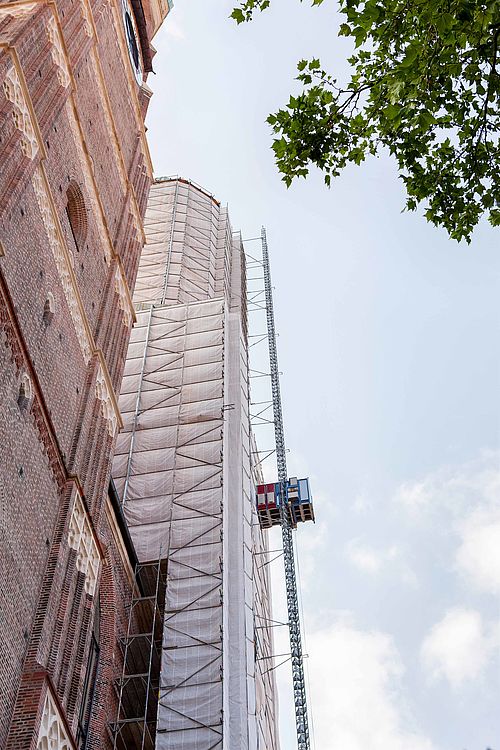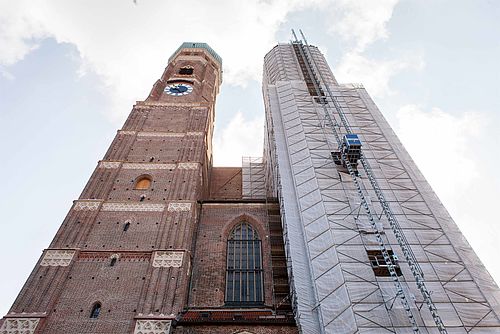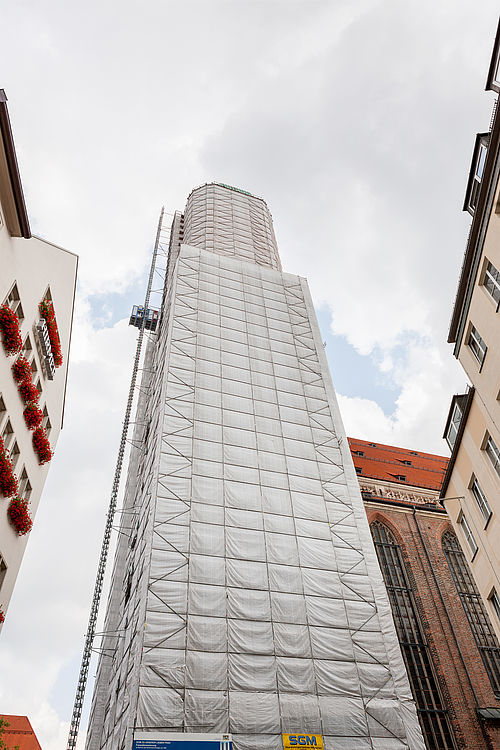Gothic meets technology
Second round of renovation of the Frauenkirche
Only a few days after the North Tower was liberated from its scaffolding, the 12 centimetre lower South Tower of Munich's Frauenkirche disappeared behind bars. The comprehensive restoration works are continuing – and once again a construction hoist from GEDA-Dechentreiter GmbH & Co. KG is being used.

The people of Munich have almost become accustomed to seeing their landmark building swathed in tarpaulin and scaffolding. Renovation work on the 526 year old cathedral has been ongoing since 2008.
The façade of the venerable Munich landmark has long been a source of worry. Fragments of bricks and stone have repeatedly become loose and threatened to crash down. The main cause is moisture. Rainwater had so badly clogged up the masonry especially on the exposed side that a total refurbishment was unavoidable. First of all on the 98.57 metre high North Tower where 179,000 individual bricks had to be examined and 20% of them had to be replaced and treated.
Now it's the same story for the South Tower. As was the case with its twelve centimetre taller brother, first of all new natural stone is being applied to the lower part of the Frauenkirche. However, bricks must also be replaced and the joint network repaired to avoid the penetration of any more moisture. The work is being made more difficult because the façade of the Frauenkirche is a patchwork of bricks and natural stone. Over the years many different types of bricks and mortar have been used. Therefore the motto of the restorers is “Less is More”. Since the historic substance of the building is to be preserved, a conscious decision was made not to use high-tech materials. Despite this decision, state-of-the-art height access technology is being used in the renovation as it must not be forgotten that each of the two cathedral towers have around 4,000 square metres of external surfaces which need to be accessible.
GEDA Multilift P18 – the best height access technology up into the dome
Already throughout the restoration work on the North Tower, a GEDA Multilift P18 Comfort transported the workers quickly and safely along the façade. The Bavarian hoist manufacturer GEDA-Dechentreiter GmbH & Co. KG received the order through its partner BNS GmbH in Chemnitz who works closely with the Munich scaffolding builder SGM Stahlrohrgerüstbau GmbH. As a result of the companies' very good working relationship and the successful restoration of the North Tower, all the companies involved once again received the contract for the Frauenkirche restoration project. And this is why a GEDA construction hoist from Bavaria is also providing valuable transportation services on the South Tower.

It is particularly in restricted spaces and in city centres, such as in the tourist centre of Munich, where the benefits of the GEDA Multilift become clear. In comparison with the larger personnel and material hoists, the Multilift hoists operate with fewer square metres of surface area. Foundations are not necessary. The full, pre-installed base unit which is composed of a car, enclosure, flat cable bin and drive is delivered as one unit with perfect dimensions for container loading and for HGV transportation. Long assembly times are now a thing of the past, as work to assemble the device can start on-site immediately without any cabin components having to be assembled in advance. Its flat, space-saving cable bin, yet another GEDA innovation, has already been integrated into the enclosure and cannot be seen at first sight. GEDA's innovative flat cable system ensures that the feared corkscrew effect is avoided.
The assembly height in the Frauenkirche is 86 metres with 28 different stops to ensure that all the different levels can be easily accessed. With a lifting speed of 32 m/min and a load capacity of 2,000 kg or 20 people, the GEDA Multilift P18 is providing valuable transportation services on the venerable cathedral and ensuring that the restoration work progresses quickly.
The integrated landing call box with its digital display in the hoist also makes it easy and practical to use here, since just as in a domestic hoist, the hoist can stop at every floor merely by pressing a button. Jerky starts or braking are avoided through the integrated frequency control.

It goes without saying that safety features such as the speed-dependent GEDA safety gear and overload protection, as well as limit switches at the top and bottom levels, are part of the standard Multilift features provided. GEDA landing-level safety gates ensure the safe transfer from the hoist to the different levels on the scaffolding. These are mechanically locked and electrically monitored so that the device does not stop or start if the landing-level safety gates are not closed correctly.
As with all GEDA rack and pinion hoists, the automatic lubrication device is included in the GEDA Multilift P18 as standard. This considerably reduces the wear on the toothed rack and pinion.
However, the façade of the Frauenkirche also presented one further challenge as the venerable walls and scaffolding only have limited load-bearing capacity. The GEDA Multilift P18 can meet this requirement thanks to its low anchoring forces.
After restoration is also before restoration
The restoration work on the South Tower is scheduled to last until 2016. However, the mammoth construction project on Munich's landmark building is by no means far from over. Once both towers are gleaming in their new splendour, it will be the nave's turn to undergo repairs. To repair damages more quickly or even to avoid them totally, Munich's historically important structure will in future be under constant observation as part of a building maintenance programme.
GEDA height access technology has once again proven that it is not only winning customers across the world but also in its Bavarian homeland. However, it will still take two years before the two towers of the Frauenkirche once again shine in their former beauty – without scaffolding.




 Download as PDF
Download as PDF Print page
Print page